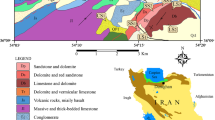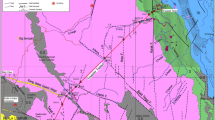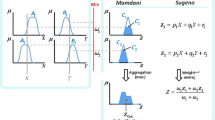Abstract
Clay bearing, weathered and other weak rocks cause major problems in engineering practice due to their interactions with water. The slake durability index (I d2) is an important tool used to assess the resistance of these rocks to erosion and degradation, but sample preparation for this test is tedious. The paper reports an attempt to define I d2 through statistical models using other parameters that are simpler to obtain. The main objective of this study was to define the best empirical relationship between the I d2 and the point load strength index (I s(50)), dry unit weight (γ d) and fractal dimension (D) parameters of eight rock types by applying general multiple linear regression (GLM), artificial neural networks (ANN) and adaptive neuro-fuzzy inference systems (ANFIS). The models obtained were evaluated using the R 2, MSE, MARE and d parameters. The results indicate that the relationships between I d2 and γ d, I s(50) and D were best obtained using ANN, followed by GLM and ANFIS. It is concluded that ANN modelling is a fast and practical method of establishing I d2.
Résumé
Les roches argileuses, altérées et d’autres roches tendres causent des problèmes importants dans la pratique du fait de leurs interactions avec l’eau. L’indice de durabilité-humidification (Id2) est un outil important utilisé pour évaluer la résistance de ces roches à l’érosion et à la dégradation, mais la préparation des échantillons pour ce test est fastidieuse. L’article présente une tentative pour définir l’indice Id2 à partir de modèles statistiques utilisant d’autres paramètres plus simples à obtenir. L’objectif principal de cette étude était de définir la meilleure relation empirique entre l’indice de durabilité-humidification (Id2) et l’indice de résistance à la compression entre pointes (Is(50)), le poids spécifique sec (γd) et le paramètre de dimension fractale (D) pour huit types de roche, faisant appel à la régression linéaire multiple générale (GLM), aux réseaux de neurones artificiels (ANN) et au systèmes d’inférence de logique floue (ANFIS). Les modèles obtenus ont été évalués en utilisant les paramètres R2, MSE, MARE et d. Les résultats indiquent que les relations entre Id2 et γd, Is(50) et D ont été plus facilement obtenues en utilisant ANN, suivit de GLM et ANFIS. Il est conclu que la modélisation ANN est une méthode rapide et pratique pour établir Id2.







Similar content being viewed by others
References
ASTM (1990) Standard test method for slake slake durability of shales and similar weak rocks (D4644). Annual book of ASTM standards, vol 4. 08. ASTM, Philadelphia, pp 863–865
Aufmuth RE (1974) Site engineering indexing of rocks: field testing and instrumentation of rock. American Society for Testing and Materials, Special Technical Publication, 554:81–99
Blatt H (1982) Sedimentary Petrology. W.H. Freeman and Company, San Francisco, CA. 564 pp
Cetin H, Laman M, Ertunc A (2000) Settlement and slaking problems in the world’s fourth largest rock-fill dam, the Ataturk Dam in Turkey. Eng Geol 56:225–242
Cigizoglu HK, Kisi O (2005) Flow prediction by three back propagation techniques using k-fold partitioning of neural network training data. Nord Hydrol 36(1):49–64
Cybenco G (1989) Approximation by superposition of a sigmoidal function. Math Control Signal 2:303–314
Dawson WC, Wilby R (1998) An artificial neural network approach to rainfall-runoff modeling. Hydrol Sci J 43(1):47–66
Dhakal G, Yoneda T, Kato M, Kaneko K (2002) Slake durability and mineralogical properties of some pyroclastic and sedimentary rocks. Eng Geol 65:31–34
Dick JA, Shakoor A, Wells N (1994) A geological approach toward developing a mudrock-durability classification system. Can Geotech J 34:17–27
El-Din AG, Smith DW (2002) A neural network model to predict the wastewater inflow incorporating rainfall events. Water Res 36:1115–1126
Franklin JA, Chandra R (1972) The slake durability test. Int J Rock Mech Min 9:325–341
Gokceoglu C, Zorlu K (2004) A fuzzy model to predict the uniaxial compressive strength and the modulus of elasticity of a problematic rock. Eng Appl Artif Intell 17:61–72
Gokceoglu C, Ulusay R, Sonmez H (2000) Factors affecting the durability of selected weak and clay-bearing rocks from Turkey, with particular emphasis on the influence of the number of drying and wetting cycles. Eng Geol 57:215–237
Golden Software (2000) Didger 2.0. Golden Software Inc., USA
Hagan MT, Menhaj M (1994) Training feedforward networks with the Marquardt algorithm. IEEE Trans Neural Netw 5(6):989–993
Hamed MM, Khalafallah MG, Hassanien EA (2004) Prediction of wastewater treatment plant performance using artificial neural networks. Environ Modell Softw 19:919–928
Haykin S (1999) Neural networks: a comprehensive foundation, 2nd edn. Prentice-Hall, Englewood Cliffs
Hornik K, Stinchcombe M, White H (1989) Multilayer feedforward networks are universal approximators. Neural Netw 2:359–366
ISRM (2007) In: Ulusay R, Hudson JA (eds) The complete ISRM suggested methods for rock characterization, testing and monitoring: 1974–2006. ISRM, Ankara
Jang JSR (1993) ANFIS: adaptive-network-based fuzzy inference system. IEEE Trans Syst Man Cybern 23(3):665–685
Jang JSR, Sun CT, Mizutani E (1997) Neuro-fuzzy and soft computing: a computational approach to learning and machine intelligence. Prentice Hall, Upper Saddle River
Juang CS, Ni SH, Lu PC (1998) A system of neural networks for deriving soil parameters from in situ tests. In: Attoh-Okine NO (ed) Proceedings of the international workshop on artificial intelligence and mathematical methods in pavement and geomechanical systems, pp 65–72
Kisi O (2005) Suspended sediment estimation using neuro-fuzzy and neural network approaches. Hydrol Sci J 50(4):683–696
Kisi O (2006) Daily pan evaporation modelling using a neuro-fuzzy computing technique. J Hydrol 329:636–646
Kolay E, Kayabali K (2006) Investigation of the effect of aggregate shape and surface roughness on the slake durability index using the fractal dimension approach. Eng Geol 86:271–284
Koncagul E, Santi PM (1998) Predicting the unconfined compressive strength of the Breathitt shale using slake durability, shore hardness and rock structural properties. Int J Rock Mech Min 36:139–153
Legates DR, McCabe GJ (1999) Evaluating the use of “goodness-of-fit” measures in hydrologic and hydroclimatic model validation. Water Resour Res 35(1):233–241
Lu Y (2005) Underground blast induced ground shock and its modelling using artificial neural network. Comput Geotech 32:164–178
Mandelbrot BB (1967) How long is the coast of Great Britain: statiscal self similarity and the fractional dimension. Science 156:636–638
More JJ (1977) The Levenberg-Marquardt algorithm: implementation and theory. In: Watson GA (ed) Numerical analysis. Lecture Notes in Mathematics, vol 630. Springer, Berlin, pp 105–116
Rezaee MR, Kadkhodaie IA, Barabadi A (2007) Prediction of shear wave velocity from petrophysical data utilizing intelligent systems: an example from a sandstone reservoir of Carnarvon Basin, Australia. J Petrol Sci Eng 55:201–212
SAS Institute Inc. (1998) SAS/STAT user’s guide, Release 7.0 ed. SAS Institute Inc., Cary
Singh TN, Sinha S, Singh VK (2007) Prediction of thermal conductivity of rock through physico-mechanical properties. Build Environ 42:146–155
Vallejo LE (1994) Fractal analysis of the slake durability test. Can Geotech J 31:1003–1008
Willmot CJ (1981) On the validation of models. Phys Geogr 2:184–194
Willmot CJ (1984) On the evaluation of model performance in physical geography. In: Gaile GL, Willmot CJ (eds) Spatial statistics and models. Springer, Dordrecht, pp 443–460
Yilmaz I, Karacan E (2005) Slaking durability and its effect on the Doline formation in gypsum. Environ Geol 47:1010–1016
Acknowledgments
The petrographic determinations were done by Dr. Y. K. Kadioglu of Ankara University. Thin section preparation and XRD analyses were carried out by Dr. N. Konak and B. Donmez of the MTA (Mineral Research and Exploration Institute). Contributions by many individuals are greatly appreciated.
Author information
Authors and Affiliations
Corresponding author
Rights and permissions
About this article
Cite this article
Kolay, E., Kayabali, K. & Tasdemir, Y. Modeling the slake durability index using regression analysis, artificial neural networks and adaptive neuro-fuzzy methods. Bull Eng Geol Environ 69, 275–286 (2010). https://doi.org/10.1007/s10064-009-0259-1
Received:
Accepted:
Published:
Issue Date:
DOI: https://doi.org/10.1007/s10064-009-0259-1
Keywords
- Slake durability index
- Regression analysis
- Artificial neural networks
- Adaptive neuro-fuzzy inference systems




